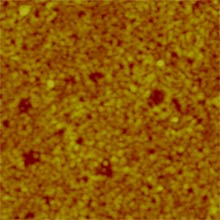Super Velcro
General Motors researchers have made an extremely strong adhesive that comes apart when heated. The adhesive is 10 times stickier than Velcro and the reusable gecko-inspired glues that many research groups have been trying to perfect.

The polymers in the glue bond to each other within minutes when they are initially heated. Thus, when two pieces of the adhesive materials are heated, they stick together strongly. Once stuck, it takes a lot of force to peel the polymers away from each other, but they come apart easily when heated again. The researchers were able to attach and pull apart the polymers twice before losing one-third of the adhesive strength, according to a Langmuir paper published online.
You can think of the material as a “chemical Velcro,” says Tao Xie, a polymer scientist who is leading the work at the GM Research and Development Center in Warren, MI. “Here the advantage is that the bond is almost as good as the liquid-based curable adhesive we’re more familiar with.”
The adhesive could lead to cars that are easy and cheap to customize. Xie envisions interchangeable car bumpers and trim in different colors. Customers could even specify where they wanted their radio, GPS system, or cup holders placed.
Mark Geoghegan, who studies reversible adhesives at the University of Sheffield in the U.K., says that strong, switchable adhesives could make it easier to recycle computers and electronics, if these adhesives were used to glue them together. “Taking complicated structures apart for reuse at the end of life of the original device is not trivial if their original production involved welding,” he says.
The glue could find use in any application requiring a strong but alterable bond, such as furniture, toys, and buildings. Geoghegan envisions offices or hotel rooms that could be tailored to accommodate a handicapped person. Or, he suggests, “Imagine a U2 tour, where sets are assembled and disassembled on a daily basis. It might be easier to use a high-strength reversible adhesive than to use bolts.”
The new material is made of a shape memory polymer, a hard plastic that becomes rubbery when heated above a certain temperature–68 ºC in this case. The researchers graft a single layer of a branched polymer on the surface of the shape memory polymer. The branched polymer contains molecules that form tight hydrogen bonds with each other.
The molecules don’t contact each other well if two pieces of the rigid shape memory polymer are pressed against each other, Xie says. “So we heat them up and then press them together, so it’s like pressing rubbers together so the [molecular] contact is good.” As a result, millions of the hydrogen-bonding molecules connect with each other, gluing the two polymer pieces together. The surfaces remain stuck when the polymer cools down and hardens.
The adhesive strength of the material is 700 newtons per square centimeter. The best gecko glue, by contrast, can withstand a force of 100 newtons before coming apart. “The adhesion strength is quite strong, and the reversibility of the system is intriguing,” says Jeffrey Karp, a bioengineer in the Harvard-MIT Division of Health Sciences and Technology who has developed gecko-inspired medical adhesives. However, he adds, the heat it requires may limit its application.
Anand Jagota, a chemical engineering professor at Lehigh University, says that while the glue’s strength shows much promise for applications in recycling and sustainable manufacturing, he wouldn’t call it a true reusable adhesive just yet. “You should be able to use a true reversible glue hundreds of times without losing its properties.”
Keep Reading
Most Popular
Large language models can do jaw-dropping things. But nobody knows exactly why.
And that's a problem. Figuring it out is one of the biggest scientific puzzles of our time and a crucial step towards controlling more powerful future models.
The problem with plug-in hybrids? Their drivers.
Plug-in hybrids are often sold as a transition to EVs, but new data from Europe shows we’re still underestimating the emissions they produce.
Google DeepMind’s new generative model makes Super Mario–like games from scratch
Genie learns how to control games by watching hours and hours of video. It could help train next-gen robots too.
How scientists traced a mysterious covid case back to six toilets
When wastewater surveillance turns into a hunt for a single infected individual, the ethics get tricky.
Stay connected
Get the latest updates from
MIT Technology Review
Discover special offers, top stories, upcoming events, and more.